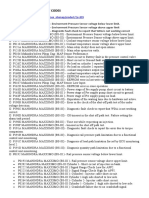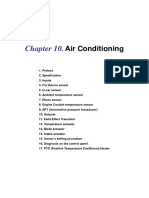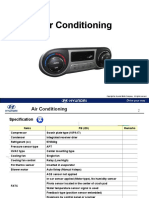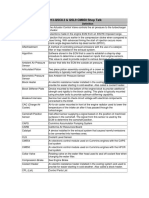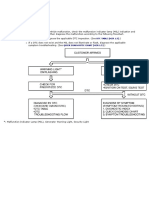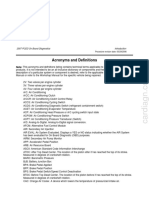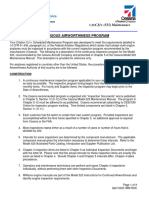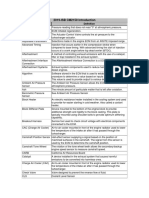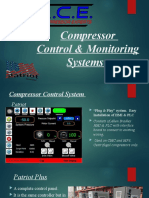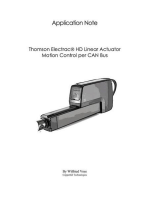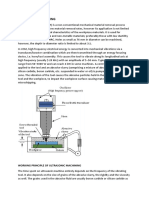Air Conditioning - I20 RM
Air Conditioning - I20 RM
Uploaded by
bhanuka2009Copyright:
Available Formats
Air Conditioning - I20 RM
Air Conditioning - I20 RM
Uploaded by
bhanuka2009Original Title
Copyright
Available Formats
Share this document
Did you find this document useful?
Is this content inappropriate?
Copyright:
Available Formats
Air Conditioning - I20 RM
Air Conditioning - I20 RM
Uploaded by
bhanuka2009Copyright:
Available Formats
Chapter 10.
Air Conditioning
1. Preface
cardiagn.com
2. Specification
3. Inputs
4. Fin thermo sensor
5. In-car sensor
6. Ambient temperature sensor
7. Photo sensor
8. Engine Coolant temperature sensor
9. APT (Automotive pressure transducer)
10. Outputs
11. Field Effect Transistor
12. Temperature actuator
13. Mode actuator
14. Intake actuator
15. Owner’s setting procedure
16. Diagnosis on the control panel
17. PTC (Positive Temperature Coefficient) Heater
Copyright by Hyundai Motor Company. All rights reserved.
Chapter 10. Air Conditioning
cardiagn.com
232 Technical Training Team 1
Chapter 10. Air Conditioning
1. Preface
To learn the air conditioning system in general and
its features.
Learning Goals To learn the air conditioning system configuration
and sectional functions.
To learn the maintenance precautions and methods.
The air conditioning (A/C) system of the PB features a number of technologies that not only provide
quality air conditioning but also reduce the failure rate through durability enhancement. In addition
the great performance will satisfy the drivers’ sensibilities.
This chapter deals with the control functions, the operating principle and diagnostic methods for the
PB’s implemented A/C system
cardiagn.com
It is hoped that this chapter will be of optimal use with the diagnosis and on-site servicing of the
system.
Technical Training Team 1 233
Chapter 10. Air Conditioning
cardiagn.com
234 Technical Training Team 1
Chapter 10. Air Conditioning
2. Specification
Items PB (i20) Remarks
Compressor Swash plate type (10PA17)
Condenser Integrated receiver drier
Refrigerant (cc) 570±20g
Pressure sensor type APT
HVAC type Center mounting type
Cooling fan Single fan
Cooling fan control Relay (Low/High)
Fin thermo sensor Inserted in evaporator
Blower motor Auto 8step (Manual 4steps)
cardiagn.com
AQS sensor not applied
In-car sensor applied (Motor type), No humidity sensor
Photo sensor located in the center of crash pad
FATC
Water temperature sensor signal is used
Feedback type (position sensor embedded)
Diagnosis by control panel or scanner
Let’s have a look at the main specification for the air conditioning system for PB (i20).
First, the variable type swash plate compressor has been applied so that the fuel consumption has been
enhanced.
Second, the condenser with integrated receiver drier was applied as same as in the recent vehicle model.
Third, the automotive pressure transducer (referred to as APT) is applied instead of the triple switch in
order to detect the refrigerant pressure.
Fourth, the center mounting type HVAC is adopted so that the blower motor and HVAC assembly are
assembled at the almost same position and the glove box capacity has been dramatically enlarged
comparing to the existing TB model.
Fifth, as for the air quality control system, the AQS sensor is not applied in PB. Also no humidity sensor is
applied.
Sixth, DC motor to intake the cabin air on the ‘In-car sensor’ has been applied instead of the conventional
aspirator hose is installed.
Seventh, photo sensor is located on the center of crash pad. Neither auto light sensor and security
indicator was applied.
Eighth, in order to control the heater comparing the temperature of inside cabin and ambient, the water
temperature sensor signal inputs to FATC control module.
Ninth, three actuators; mode, intake door and temperature have the position sensor so that the control
module may feedback the operation of each actuator.
Tenth, using the scanner or button pressing on the FATC control panel, it is possible to diagnose.
Technical Training Team 1 235
Chapter 10. Air Conditioning
A/C compressor
cardiagn.com
236 Technical Training Team 1
Chapter 10. Air Conditioning
3. Inputs
Block diagram Tail lamp, Rheostat (illumination)
Fin thermo sensor
In-car sensor
Ambient temperature sensor
Photo sensor
FATC
control
Water temperature sensor module
cardiagn.com
APT Vehicle speed
Switches
Auto, OFF, A/C, Recirculation,
Fresh, Defroster, Defogger, Mode, Blower speed
Eng. ECM
Dial switch (temperature)
Power (B+, IG2) and Ground
Use the link button to move the page related to the each item in next page.
Vehicle speed
The PCM (or vehicle speed sensor) sends the signal of vehicle speed via hardwire to FATC control module
so that it will be used for the air conditioning control logic.
Technical Training Team 1 237
Chapter 10. Air Conditioning
4. Fin thermo sensor
Location & Specification
cardiagn.com
Sensor ground Sensor power (5V)
Temp. (℃) Voltage (V) Temp. (℃) Voltage (V)
40 0.94 2 2.55
30 1.25 0 2.66
20 1.64 -5 2.94
10 2.12 -10 3.22
It is inserted on the HVAC and detects the temperature of evaporator core in order to control the cooling
and avoid the evaporator to be frozen.
A/C Off: 2 (±0.5)℃, A/C On: 4℃
The negative thermal coefficient type sensor is applied so that the output voltage from the sensor is in
inverse proportional to the temperature as shown in the table of training manual.
Failsafe of fin thermo sensor
If the fin thermo sensor is open or shorted circuit, the temperature will be alternated by -2℃.
238 Technical Training Team 1
Chapter 10. Air Conditioning
5. In-car sensor
Location & Specification
cardiagn.com
In-car sensor motor (-) Sensor ground Sensor power (5V)
Temp. (℃) Voltage (V) Temp. (℃) Voltage (V)
60 1.00 0 3.83
40 1.74 -20 4.52
20 2.78 -40 4.84
In car sensor senses the temperature of cabin in order to control the target temperature which is set by the
driver. In PB, the motor type was applied to intake the cabin air compulsory.
Failsafe of In-car sensor
If the In-car sensor is open or shorted circuit, the temperature will be alternated by 25℃.
Technical Training Team 1 239
Chapter 10. Air Conditioning
6. Ambient temperature sensor
Location & Specification
cardiagn.com
FATC
FATC
Sensor power
Ambient
(signal)
temperature sensor
Trip computer
Sensor power
(signal)
Sensor ground
It is located at the front of radiator and detects the temperature of outside air.
Be sure that this sensor signal directly inputs to both FATC and Trip computer as shown in the picture.
Compensation of measured value
To reduce the error depending on the condition, the system compensates the measured temperature as
follows.
- When the temperature drops: it detects immediately.
- When the temperature rises: it detects after 1min as long if the vehicle runs more than 25kph and 1℃
rises.
- When the engine restarts
1) If restarts before 1hour from IG off, the last temperature memorized when turns off the engine will
be displayed.
2) If restarts after 1hour from IG off, the system detects the current temperature and display it.
3) If the engine coolant temperature is higher than 50℃, the temperature memorized when turns off
the engine will be displayed.
240 Technical Training Team 1
Chapter 10. Air Conditioning
4) If the engine coolant temperature is lower than 50℃, the current temperature will be displayed.
Failsafe of ambient temperature sensor
If the ambient temperature sensor is open or shorted circuit, the temperature will be alternated by 20℃.
cardiagn.com
Technical Training Team 1 241
Chapter 10. Air Conditioning
7. Photo sensor
Location & Specification
cardiagn.com
Sensor ground Sensor power (5V)
Photo sensor is located at the center of crash pad and it is used to control the blower speed and automatic
temperature. Also the system will compensate the cabin temperature based on the sensing value from the
photo sensor. Due to the fact that neither auto light system nor security indicator is applied in PB, only the
photo sensor itself will function.
Failsafe of photo sensor
If the photo sensor is open or shorted circuit, it will be fixed with zero W/m2 (no sun light).
242 Technical Training Team 1
Chapter 10. Air Conditioning
8. Engine Coolant temperature sensor
Location & Specification
cardiagn.com
ECT
temperature FATC
sensor
ECM, Cluster
The engine coolant temperature sensor is located at the engine room and it is shared with engine ECM,
cluster and FATC control module in order to control the heater. As same as other temperature sensors, the
negative thermister type so that the output voltage from the sensor will drop as the coolant temperature
increases.
Failsafe of engine coolant temperature sensor
If the engine coolant temperature sensor is open or shorted circuit, the temperature will be alternated by
85℃.
Technical Training Team 1 243
Chapter 10. Air Conditioning
9. APT (Automotive pressure transducer)
Location & Specification
cardiagn.com
A/C Switch
signal (HI)
A/C output
Eng.
Blower switch ON signal
ECM
APT
It continuously senses the refrigerant pressure and inputs to the engine ECM (not the FATC control
module) in order to control the compressor and cooling fan for optimum cooling performance.
- It substitutes the conventional triple switch
- It contributes to the lower fuel consumption and smooth shift feeling
- APT outputs the voltage and it inputs to engine ECM as shown in the below graph.
244 Technical Training Team 1
Chapter 10. Air Conditioning
100
90 (469.847PSI, 90%V)
(High pressure 4.5V)
80
70
Output voltage 60
(%V) 50
40
30
20
(Low pressure 0.5V) 10
14.7psi Refrigerant 469.847psi
pressure 32.0(kgf/㎠)
0.0(kgf/㎠)
On
cardiagn.com
Compressor
Off
2.2 ㎏ f/㎠ G 2.5 ㎏ f/㎠ G 25 ㎏ f/㎠ G 31 ㎏ f/㎠ G
Technical Training Team 1 245
Chapter 10. Air Conditioning
10. Outputs
Block diagram
FET / Blower motor
Temperature actuator
Mode actuator
FATC Intake actuator
control
module Rear
BCM
cardiagn.com
Rear
Compressor
A/C
Blower Eng. ECM Resistor
A/C
Condenser fan
K-line
246 Technical Training Team 1
Chapter 10. Air Conditioning
11. Field Effect Transistor
Location & Specification
Blower relay
D FET
F/B
cardiagn.com
G S
FET Gate voltage output
FET Drain voltage feedback
The blower motor speed has 8 steps (auto) and 4 steps (manual) respectively. As same as the
conventional type, FET has been applied and the blower motor is powered blower relay which will be
energized upon ignition on.
Following table is for the blower motor voltage depending on the speed level.
Blower speed Motor voltage (V)
1st 4.00
2nd 5.12
3rd 6.24
4th 7.36
5th 8.48
6th 9.60
7th 10.72
8th BATT
Technical Training Team 1 247
Chapter 10. Air Conditioning
12. Temperature actuator
Location & Specification
cardiagn.com
Temp. actuator Temp. actuator (Heating)
Sensor
ground
Sensor
power (5V)
Temp. actuator
Sensor
f/back
Temp. actuator (Cooling)
Sensor power 5V
HI (32°C) 4.55V
LO (17°C) 0.45V
248 Technical Training Team 1
Chapter 10. Air Conditioning
When FATC module controls during auto or manual, the temperature can be varied from 17℃ to 32℃ by
0.5℃. This actuator will mix the cool air from the evaporator and hot air from the heater.
Failsafe of temperature actuator position sensor: If the temperature actuator position sensor is open or
shorted circuit;
1) hen the user setting temperature is 17℃ to 24.5℃ ◊ controlled with max. cooling
2) When the user setting temperature is 25℃ to 32℃ ◊ controlled with max. hot
cardiagn.com
Technical Training Team 1 249
Chapter 10. Air Conditioning
13. Mode actuator
Location & Specification
Mode actuator Mode actuator (Defroster)
cardiagn.com
Sensor ground
Sensor
power (5V)
Mode actuator (Vent)
Mode actuator
Sensor
f/back
Sensor power 5V
Vent 0.45V
Bi-level 1.50V
Floor 2.65V
Mix 3.50V
Defroster 4.55V
Depending on the setting temperature and ventilation mode, it is controlled by FATC module.
- During auto or manual mode control, the blow direction can be changed by FATC
250 Technical Training Team 1
Chapter 10. Air Conditioning
- FATC module will turn off the mode actuator when it reaches to the target position in order to keep the
target direction.
Failsafe of mode actuator position sensor:
If the mode actuator position sensor is open or shorted circuit;
1) When the user setting mode is ‘Vent’, it will be fixed with ‘Vent’ mode.
2) When the user setting mode is other than ‘Vent’, it will be fixed with ‘Defroster’ mode.
cardiagn.com
Technical Training Team 1 251
Chapter 10. Air Conditioning
14. Intake actuator
Location & Specification
Recirculation/Fresh
cardiagn.com
A-connector B-connector
Terminal Voltage
B-2 Sensor power(5V)
B-11 Sensor feedback
B-6 Sensor ground
A-22 Fresh mode
A-23 Recirculation mode
Failsafe of intake door actuator position sensor
If the intake door actuator position sensor is open or shorted circuit;
1) When the user setting mode is ‘fresh’, it will be fixed with ‘fresh’ mode.
2) When the user setting mode is ‘recirculation, it will be fixed with ‘recirculation’ mode.
252 Technical Training Team 1
Chapter 10. Air Conditioning
15. Owner’s setting procedure
Defroster logic control
Cannot be changed !
Temperature unit conversion
cardiagn.com
OFF button + AUTO button (3sec)
Defroster logic control
PB will not be launched in Korean and North American market so that the defroster logic (A/C will be
turned on compulsory whenever front defroster button is switch on) cannot be reset.
Temperature unit conversion
Following is the procedure of temperature unit conversion.
- Keep to press OFF button and press AUTO button for 3sec.
Technical Training Team 1 253
Chapter 10. Air Conditioning
16. Diagnosis on the control panel
Procedure
IGN S/W: OFF→ON
cardiagn.com
Keep pressing OFF switch and press Mode switch 4 times
within 2sec.
Press OFF
Self-diagnosis
(Continuous check)
Press AUTO Press AUTO
Proceed to next step by A/C switch Self-diagnosis
(Step by step)
Press OFF
FULL AUTO control
- Only two digits will be used to display the trouble code and other digits will be off at that time.
- The A/C control will stop when the system is diagnosed.
- The trouble code info will be shown at the FATC panel in every 0.5sec.
- While the system is diagnosed, if the ignition key is off & on, then the system will be restored to A/C off
condition.
- After completion of system diagnosis, the A/C control will be done based on the temperature set before
diagnosis.
- PTC (Positive Temperature Coefficient) Heater
254 Technical Training Team 1
Chapter 10. Air Conditioning
17. PTC (Positive Temperature Coefficient) Heater
PTC relay 3 PTC relay 2 PTC relay 1
PTC heater
cardiagn.com
Location of PTC relay 1, 2 and 3
Following is the operating condition of the PTC heater applied in diesel specification only.
- Condition: Blower motor rotates and PTC operation set to ‘ON’ (low)
PTC relay control:
After PTC ON signal inputs, PTC relay 2 will be actuated after 15sec. In case of OTC relay 3, it can be on
or off depending on the battery voltage level as follows.
PTC ON
PTC OFF
11.5V 12.4V
Pin Description
A-19 PTC ON SIGNAL
A-10 PTC RELAY #2
A-11 PTC RELAY #3
Technical Training Team 1 255
Chapter 10. Air Conditioning
Condition satisfied
Relay control
PTC PTC PTC
relay 1 relay 2 relay 3
Engine
ECM
cardiagn.com
Heater
controller
Blower motor Relay Control
control
As all the operating conditions are met, the engine ECM will drive the PTC relay 1 at first so that the PTC
heater may operate.
As long as the battery voltage level is normal, relay 2 and 3 will operate accordingly after 15sec.
If the engine was already warmed up or the operating conditions are not met, the engine ECM will turn off
the PTC relay 1 at first. After that, the heater controller will turn off the PTC relay 2 and 3 accordingly with
the time delay of 15sec respectively.
Even if the PTC relay 1 is driven by engine ECM, the heater controller can monitor the status of PTC
relay 1 due to the monitoring line connected to the relay as shown in the picture.
In addition, the maximum operating time of PTC cannot exceed 60min.
256 Technical Training Team 1
You might also like
- CFM Doc Leap 1b Co Sys 3 v2Document83 pagesCFM Doc Leap 1b Co Sys 3 v2Paulo Sanz100% (1)
- Mahindra Maximo Fault CodesDocument3 pagesMahindra Maximo Fault Codesbhanuka2009No ratings yet
- Manual KTE-1000AHUDocument101 pagesManual KTE-1000AHUzalomxisNo ratings yet
- Manufacturer List - PE Pipe As Per IS 4984:2016: State Variety BrandDocument412 pagesManufacturer List - PE Pipe As Per IS 4984:2016: State Variety BrandÀVÎNÂSH RAAZNo ratings yet
- Hyundai I20 Air ConditioningDocument26 pagesHyundai I20 Air ConditioningReza Varamini100% (2)
- Full Authority Digital Engine Control FADEC System PDFDocument18 pagesFull Authority Digital Engine Control FADEC System PDFberjarry593875% (4)
- V2500lbmissue01 150709153241 Lva1 App6891Document603 pagesV2500lbmissue01 150709153241 Lva1 App6891Benhur Roberto Eboli Román100% (4)
- Wabco Atc CanDocument36 pagesWabco Atc CanCostel Caraman100% (1)
- 2 G3600 A3 System OperationDocument67 pages2 G3600 A3 System Operation巴啦啦No ratings yet
- Building Management SystemsDocument27 pagesBuilding Management Systemsped376100% (2)
- Man Truck Central Electrical System System Descryption T80 Trucknology Generation A TG-ADocument21 pagesMan Truck Central Electrical System System Descryption T80 Trucknology Generation A TG-AServicepart Support100% (7)
- Active Stability Control System (ASC) - 2010 LancerDocument306 pagesActive Stability Control System (ASC) - 2010 Lancerbhanuka2009No ratings yet
- Air Brake System TroubleshootingDocument5 pagesAir Brake System Troubleshootingbhanuka2009100% (1)
- Ed Aircon PDFDocument17 pagesEd Aircon PDFChandrashekhar NeeliNo ratings yet
- (Dual Automatic Temperature Control) : 2. Component 3. Control System 4. Service and MaintenanceDocument24 pages(Dual Automatic Temperature Control) : 2. Component 3. Control System 4. Service and Maintenancenam gaNo ratings yet
- PB Air Conditioning EngDocument18 pagesPB Air Conditioning EngNitin VanjariNo ratings yet
- Sensor CatalogueDocument72 pagesSensor Cataloguefurious man67% (3)
- 15 - Engine Control System: Workshop Manual - Diablo 6.0Document83 pages15 - Engine Control System: Workshop Manual - Diablo 6.0jahzooneNo ratings yet
- Section 1 - IntroductionDocument31 pagesSection 1 - Introductionripan thakurNo ratings yet
- v2500lm01r02 General PDFDocument28 pagesv2500lm01r02 General PDFKamalVirk100% (1)
- Description: PrintDocument8 pagesDescription: PrintAUTOSCOPE DIAGNOSIS PERUNo ratings yet
- 2013-QSC8.3 & QSL9 CM850 Shop TalkDocument6 pages2013-QSC8.3 & QSL9 CM850 Shop Talkralph arisNo ratings yet
- AIRmatic With ADS Control Unit, Component DescriptionDocument2 pagesAIRmatic With ADS Control Unit, Component Descriptionhajiamani531No ratings yet
- ForewordDocument9 pagesForewordLchJmesNo ratings yet
- A 3 1 8 /A 3 1 9 /A 3 2 0 /A 3 2 1 A 3 3 0 /A 3 4 0: AbbreviationsDocument22 pagesA 3 1 8 /A 3 1 9 /A 3 2 0 /A 3 2 1 A 3 3 0 /A 3 4 0: Abbreviationsjunebug172No ratings yet
- абривиатура крайслерDocument15 pagesабривиатура крайслерАндрей ПеченевскийNo ratings yet
- 02 Engine PDFDocument1,000 pages02 Engine PDFFranco Franco TovarNo ratings yet
- Aircraft Engine's Smart ControlsDocument37 pagesAircraft Engine's Smart ControlsMadhur BhaiyaNo ratings yet
- 2024-ISB/ISC/ISL CM2150 Crankcase BreatherDocument7 pages2024-ISB/ISC/ISL CM2150 Crankcase Breatherralph arisNo ratings yet
- SM 54Document98 pagesSM 54johanns100% (1)
- CPVR 20 TMD CaliberDocument13 pagesCPVR 20 TMD CaliberJitendra KadamNo ratings yet
- Acronyms and DefinitionsDocument8 pagesAcronyms and DefinitionsAlbert BriceñoNo ratings yet
- Revisões CJ1Document9 pagesRevisões CJ1ppmlvcj1plusNo ratings yet
- 2022-ISC/ISL CM2150 Shop TalkDocument7 pages2022-ISC/ISL CM2150 Shop Talkralph arisNo ratings yet
- Body SectionDocument580 pagesBody Sectionjhon greig100% (1)
- Ekatalog - Teknik Kendaraan Ringan OtomotifDocument2 pagesEkatalog - Teknik Kendaraan Ringan OtomotifRenji Purnama AlaisNo ratings yet
- 2019-ISB CM2150 IntroductionDocument7 pages2019-ISB CM2150 Introductionralph arisNo ratings yet
- 2020-ISB CM2150 Shop TalkDocument7 pages2020-ISB CM2150 Shop Talkralph arisNo ratings yet
- JalTestSoft Innovations List 12.2 EnglishDocument183 pagesJalTestSoft Innovations List 12.2 EnglishChristopherNo ratings yet
- Hyundai Elantra 1.6 General Information1Document17 pagesHyundai Elantra 1.6 General Information1MANUALES2000CLNo ratings yet
- Patriot Controls Presentation SalesDocument17 pagesPatriot Controls Presentation Salessteveac3No ratings yet
- 2025-ISB/ISC/ISL CM2150 Control SystemDocument7 pages2025-ISB/ISC/ISL CM2150 Control Systemralph arisNo ratings yet
- 2023-ISC/ISL CM2150 Fuel SystemDocument7 pages2023-ISC/ISL CM2150 Fuel Systemralph arisNo ratings yet
- Automatic Climate Control SystemDocument9 pagesAutomatic Climate Control SystemSyahiran Sharif100% (1)
- Airmatic w220 S Class EncyclopediaDocument45 pagesAirmatic w220 S Class EncyclopediaДиспечер ВиКNo ratings yet
- Technical Caterpillar C 9.3 Auxiliary EngineDocument44 pagesTechnical Caterpillar C 9.3 Auxiliary EngineSan KumarNo ratings yet
- Detroit Transmissions Electronic ACRONYMSDocument4 pagesDetroit Transmissions Electronic ACRONYMScells-crosser0xNo ratings yet
- Ecu/EmsDocument17 pagesEcu/EmsOtto H. Subiantoro100% (1)
- KomatsuAcronyms NEW 020511Document14 pagesKomatsuAcronyms NEW 020511dieselessllcNo ratings yet
- Standard Equipment Optional Equipment: We Build A Better FutureDocument9 pagesStandard Equipment Optional Equipment: We Build A Better FutureJose Carmona100% (1)
- 2013 Vector Unit FTF Handbook PDFDocument56 pages2013 Vector Unit FTF Handbook PDFJuan Miguel Marin Quintero100% (1)
- Emsecu 131128190203 Phpapp02Document17 pagesEmsecu 131128190203 Phpapp02Nikunj YagnikNo ratings yet
- 2004 Legacy Service Manual Quick Reference Index Body SectionDocument50 pages2004 Legacy Service Manual Quick Reference Index Body Sectionjefe_e578726No ratings yet
- 1-Nguyen Ly Cua OBD (English)Document9 pages1-Nguyen Ly Cua OBD (English)Thanh Tùng HuỳnhNo ratings yet
- Chery Carry A18 ENGINE ELECTRICAL SYSTEM - E PDFDocument89 pagesChery Carry A18 ENGINE ELECTRICAL SYSTEM - E PDFEduar SevillaNo ratings yet
- 3412C Marine Engine High Performance 3JK00146-UP (SEBP2969 - 54) - Documentación PDFDocument29 pages3412C Marine Engine High Performance 3JK00146-UP (SEBP2969 - 54) - Documentación PDFmanuel100% (1)
- Deckma OMD2008 15ppm Bilge AlarmDocument29 pagesDeckma OMD2008 15ppm Bilge AlarmLuke WilsonNo ratings yet
- Thomson Electrac HD Linear Actuator Motion Control per CAN BusFrom EverandThomson Electrac HD Linear Actuator Motion Control per CAN BusNo ratings yet
- Stories from the Road 6: An Automotive Case Studies SeriesFrom EverandStories from the Road 6: An Automotive Case Studies SeriesNo ratings yet
- Practical, Made Easy Guide To Building, Office And Home Automation Systems - Part OneFrom EverandPractical, Made Easy Guide To Building, Office And Home Automation Systems - Part OneNo ratings yet
- Tata VentureDocument3 pagesTata Venturebhanuka2009No ratings yet
- Disc BrakesDocument33 pagesDisc Brakesbhanuka2009100% (1)
- Cruise ControlDocument15 pagesCruise Controlbhanuka2009No ratings yet
- Vibration Diagnosis and CorrectionDocument54 pagesVibration Diagnosis and Correctionbhanuka2009No ratings yet
- Hydraulic BrakesDocument74 pagesHydraulic Brakesbhanuka2009No ratings yet
- IntroductionDocument30 pagesIntroductionbhanuka2009No ratings yet
- Squeaks and RattlesDocument1 pageSqueaks and Rattlesbhanuka2009No ratings yet
- Safer, Smarter Drivers: More InformationDocument2 pagesSafer, Smarter Drivers: More Informationbhanuka2009No ratings yet
- Traffic Lights: Service CentresDocument3 pagesTraffic Lights: Service Centresbhanuka2009No ratings yet
- Giving WayDocument8 pagesGiving Waybhanuka2009No ratings yet
- Worksheet A: Mdps (Mando)Document6 pagesWorksheet A: Mdps (Mando)bhanuka2009No ratings yet
- Worksheet A: U-II Engine FamiliarizationDocument6 pagesWorksheet A: U-II Engine Familiarizationbhanuka2009No ratings yet
- 17-594 Shift Lock Control Shift Lock Control Schematic and Routing DiagramsDocument7 pages17-594 Shift Lock Control Shift Lock Control Schematic and Routing Diagramsbhanuka2009No ratings yet
- Ask Your Own Heavy Equipment Question: Ask This Expert Ask Any ExpertDocument2 pagesAsk Your Own Heavy Equipment Question: Ask This Expert Ask Any Expertbhanuka2009No ratings yet
- Ultratech Cement: Particulars Test Results Requirements ofDocument1 pageUltratech Cement: Particulars Test Results Requirements ofRajeshNo ratings yet
- 1203 Jacking E WebDocument16 pages1203 Jacking E Webfbm9318No ratings yet
- Design of Vertical Beam (Gate) Loading CalculationDocument7 pagesDesign of Vertical Beam (Gate) Loading CalculationSivaArabiNo ratings yet
- Casting Quality Improvement by GatiDocument5 pagesCasting Quality Improvement by GatiAnendra RestuNo ratings yet
- Bảng tính toán tải nhiệtDocument38 pagesBảng tính toán tải nhiệtLê Minh QuangNo ratings yet
- Sicurezza Antincendio: Titolo Presentazione SottotitoloDocument15 pagesSicurezza Antincendio: Titolo Presentazione Sottotitoloahsan ahmadNo ratings yet
- Injection Molding DOEDocument8 pagesInjection Molding DOEMatt McLouthNo ratings yet
- Uniaxial Geotest-1000 Unconfined Rock Compression Test SystemDocument2 pagesUniaxial Geotest-1000 Unconfined Rock Compression Test Systemtenri wijaNo ratings yet
- Arklite Specialty Lamps, Limited - Pune: Department:-Dta Uvq Job Sheet For Gph178T5Vh 200 Nos (So 103)Document1 pageArklite Specialty Lamps, Limited - Pune: Department:-Dta Uvq Job Sheet For Gph178T5Vh 200 Nos (So 103)gaurav tatheNo ratings yet
- Telephone-Cables FINOLEX PDFDocument2 pagesTelephone-Cables FINOLEX PDFsantosh kumarNo ratings yet
- Buffer Tank Hesabı PDFDocument4 pagesBuffer Tank Hesabı PDFDevrim GürselNo ratings yet
- Cube Test Register FormatDocument8 pagesCube Test Register FormatmayurattardeNo ratings yet
- TDS Conplast WL India3Document2 pagesTDS Conplast WL India3rajni phNo ratings yet
- PDF 20 FT Bender InstructionsDocument46 pagesPDF 20 FT Bender Instructionszayboy1No ratings yet
- Swastik Cements Floriculture and Vertical FarmingDocument3 pagesSwastik Cements Floriculture and Vertical FarmingcvwNo ratings yet
- 262609288Document25 pages262609288Shaheeb Majeed100% (1)
- Notes:: Reinforcement in Manhole Chamber With Depth To Obvert Greater Than 3.5M and Less Than 6.0MDocument1 pageNotes:: Reinforcement in Manhole Chamber With Depth To Obvert Greater Than 3.5M and Less Than 6.0Mسجى وليدNo ratings yet
- Model Exam.2.2Document3 pagesModel Exam.2.2Srinivasan PichandiNo ratings yet
- FINAL EXAMINATION WoodworkingDocument2 pagesFINAL EXAMINATION WoodworkingROSELYN N. YDQUILANo ratings yet
- Sor 2015 WbsrdaDocument56 pagesSor 2015 WbsrdaTECHNOCONS CONST.No ratings yet
- Training Manual For PVelite Basic LevelDocument41 pagesTraining Manual For PVelite Basic LevelsudokuNo ratings yet
- Guideline Facade Sikasil Weather Sealants enDocument9 pagesGuideline Facade Sikasil Weather Sealants enRemielNo ratings yet
- Squah Court QuotationDocument3 pagesSquah Court QuotationOmair Akhtar KhanNo ratings yet
- Polymers IDocument28 pagesPolymers IMichael Angelo FilomenoNo ratings yet
- 19 1 s2.0 S0264127522008802 MainDocument13 pages19 1 s2.0 S0264127522008802 MainVafa MirzaeiNo ratings yet
- Waterproofing Sample Submittal FormDocument3 pagesWaterproofing Sample Submittal FormYati ChanNo ratings yet
- Slivnik - History and Classification of Three-Hinged Arch BridgesDocument12 pagesSlivnik - History and Classification of Three-Hinged Arch BridgesmartrantNo ratings yet
- Maintenance Objectives of Highway MaintenanceDocument38 pagesMaintenance Objectives of Highway Maintenanceعمر ازهر محمد حاجمNo ratings yet
- Working Principle of Ultrasonic MachiningDocument7 pagesWorking Principle of Ultrasonic MachiningYogesh KandaNo ratings yet

